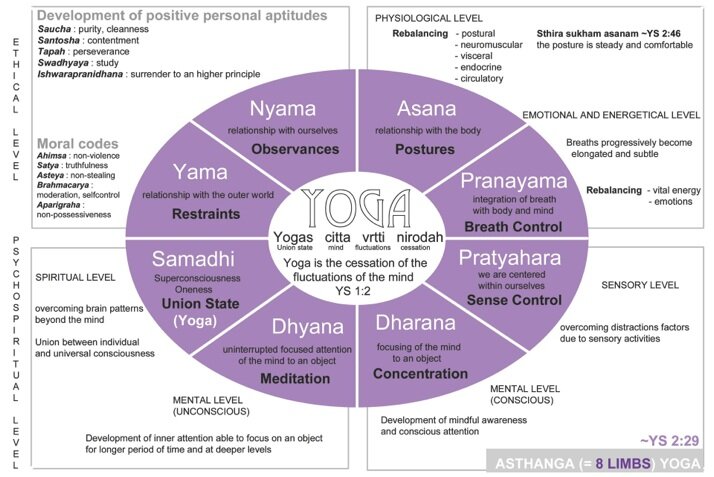What is Yoga, really?
If you are like most people, the term Yoga is mostly about a physical practice performed on a mat that involves a series of awkward poses with funny sounding names. Whilst this is true to an extent, yoga is actually way more interesting than this.
Whilst it is true that it is essentially a spiritual discipline, a better way to think of it is as the art and science of healthy living. The word ‘Yoga’ is derived from the sanskrit root ‘Yuj’, meaning ‘to join’ or ‘to yoke’ or ‘to unite’. The practice of Yoga offers a path to the union of individual consciousness with that of universal consciousness, in other words, creating perfect harmony between the mind, body and everything in the universe (modern quantum physics is proving that everything is essentially made of the same stuff - vibrating patterns of energy, however they seemed to know this already many thousands of years ago).
It’s worth noting at this point that there is no single version of Yoga. In fact, there are at least four main schools of yoga that have sprung from various ancient traditions and lineages that offer a path towards harmomizing oneself with the rest of the universe.
Jnana Yoga - the path of seeking correct knowledge.
Bhakti Yoga - the path of devoting oneself to ‘god’.
Karma Yoga - the path of excellence in all actions
Raaj Yoga - the path of meditation and inner experience
Later, four more traditions spring up and are considered supplementary practices. These include:
Kundalini Yoga - the path of awakening chakras and subtle energy channels.
Mantra Yoga - the path of using chanting.
Laya Yoga - the path of absorption of sound including music and sounds of nature.
Hatha Yoga - the path of opening the physical body.
Let’s meet Patanjali
A few thousand years ago, a guy by the name of Maharshi Patanjali decided it was all getting a bit too confusing and decided to bring together the existing materials and knowledge that were associated with the term Yoga into a complete system of knowledge. Out of this came the famous ‘Yoga Sutras’ (verses in Sanskrit language that give instruction about the practice of Yoga), 196 in total.
The second verse of the Yoga Sutras is Yogah Chitta Vritti Nirodhah, which literally means Yoga is stopping/controlling/eliminating the patterns of the mind. Yes, Yoga is about the mind far more than it is about the physical body, and this was the thing that I found fascinating it was brought to my attention. Yoga is essentially a thousands-years-old mental resilience and strengthening program to help us achieve what we want in life. In a world that is challenging many people’s mental resilience, anything that works is worth learning more about.
The good news is that Patanjali then made it even easier for everyone by creating what is known as Ashtanga Yoga, which literally means 8-limbed path. What he is essentially saying is that in order to properly explore your inner world and discover your true self through meditation, one must first address the root causes of why our minds ‘spin’ in the first place.
Here is the 8 limb path represented in a diagram:
Start with ‘Yama’ and work clockwise
In the modern world, there are plenty of people suggesting all sorts of techniques for living a better life. Gratitude, Detoxes, Meditation, Non-Violence. The interesting thing about the 8-limbed path is that all of these are already included, and provided in a type of order that builds on each other. Think of these as choices that we can make rather than ‘commandments’ to follow. Yoga is a practice rather than necessarily a final destination (although remember, the purpose is to achieve self-realization, knowledge of oneself).
If we start with the Yamas (social ethics), you will see that we are invited to consider our relationship with the following:
Non-violence. This is not just about physical harm, it is about our thoughts, words and actions towards all living things (including nature and ourselves!).
Truthfulness. This is not just about not telling fibs to others, but also about the stories and lies we tell ourselves.
Non-stealing. This is not just about taking physical possessions away from others, it is about stealing things like time and reputation away from others and ourselves.
I would encourage you to look at the diagram and start with where you see the term ‘yamas’. Then work clockwise to the left through Niyamas, Asanas, Pranayama etc.
I could literally write for hours about all of these topics, however my suggestion is to start looking through these yourself. And if you would like to discover how you can incorporate this knowledge into everyday life, without having to necessarily place your body into weird poses or wear tight-fitting yoga clothing, check out our workshop Yoga As A Way Of Life For Everyday People.

